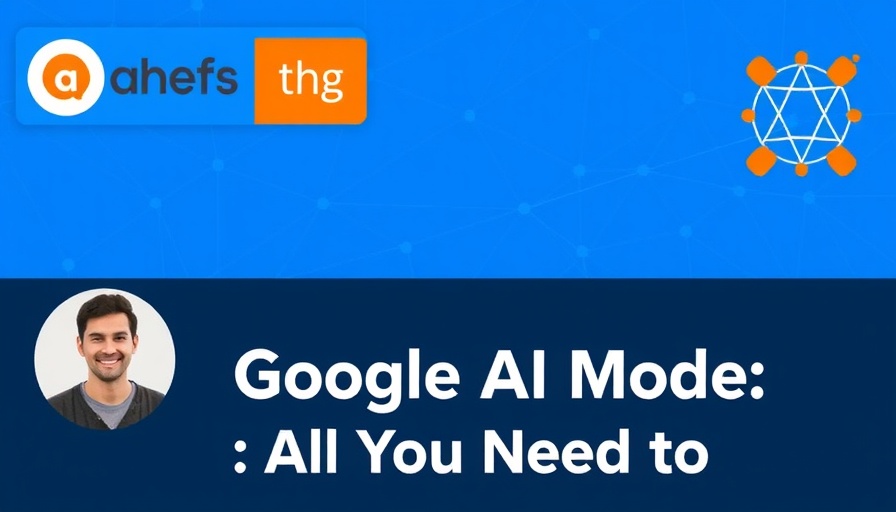
Understanding Google AI Mode: A New Era for Search
Google AI Mode has emerged as a transformative tool for businesses and users alike since its launch as a labs experiment on March 5, 2025. By welcoming this innovative feature, Google is reshaping the search experience from a list-based format to a more conversational, interactive exchange. No longer do users need to sift through numerous links to find precise information; AI Mode generates direct answers and offers interactive follow-up options, fundamentally changing how we approach searching.
How Businesses Can Benefit from AI Mode
For small and medium-sized businesses (SMBs), adapting to AI Mode could significantly enhance digital marketing strategies. The AI's querying capabilities enable businesses to optimize their content for succinct answers that resonate with users' questions. AI Mode employs a multimodal approach, leveraging typed, spoken, and image inquiries for answers. Hence, SMBs could consider updating their FAQs to cater to diverse query types.
A Glance at AI-Driven Interactivity
Imagine telling Google, "Find a vegetarian restaurant near me that can accommodate eight people this Saturday at 6 PM." Instead of simply pointing you toward standard listings, AI Mode interprets your request and generates options instantly, thus improving overall efficiency. This agentic function can be a game-changer for businesses by allowing users to make reservations, perform searches, and even complete transactions through simple voice or text commands, bridging gaps in client communication.
Preparing for the Shift: What Businesses Need to Do
As Google rolls out AI Mode across 180 countries, businesses must focus on preparedness for this paradigm shift in consumer expectations. Ensuring that your content is accessible and aligned with AI search parameters is critical. Incorporate structured data and clear, direct answers into your content to facilitate the AI's ability to pull from your website. Engaging with potential customers through direct answers will set businesses apart.
Real-World Examples of Effective Adaptation
Several businesses have begun to see the advantages of integrating AI Mode into their operations. Brands that have optimized their digital presence through SEM strategies are reaping rewards. For instance, a local bakery that optimized its site with clear product descriptions, images, and accurate metadata has seen a significant increase in online orders, thanks in part to better visibility in AI Mode searches. Effective use of social media to engage with customers and gather feedback through these searches is another beneficial practice.
Future of Search: What Lies Ahead
Google's ultimate vision with AI Mode involves creating an agentic search tool capable of fulfilling complex requests autonomously. Imagine a day when users can communicate with their devices in natural language and receive personalized service—this prospect is becoming increasingly reality as AI evolves. Businesses should not only prepare for this now-reality but also invest in future-proofing their digital marketing strategies to stay relevant in the years to come.
Common Misconceptions about AI Search
Despite the rapid advancements, some misconceptions persist regarding AI tools. For instance, many worry that AI Mode will overshadow traditional SEO practices. However, the truth is that AI Mode requires robust SEO to function effectively—businesses that adapt and optimize will continue to find success. Moreover, AI’s growth towards understanding context and sentiment means that customer satisfaction will always play a substantial role in determining visibility and engagement.
Emotional Engagement: The Human Element
At the heart of these innovations is the user experience. Businesses that prioritize creating authentic connections with their clientele—by responding to AI-generated insights, asking for feedback, and enhancing interactivity—are bound to foster loyalty in a world increasingly governed by technology. Customers will appreciate brands that listen and evolve based upon AI insights, which also supports a sense of belonging and community.
As Google’s AI Mode continues to evolve, staying informed and proactive is key for businesses. Engaging with this technology not only enhances visibility but creates opportunities for deeper connections with consumers. Doing so could very well define the next generation of business success. Embrace the change, and stay ahead of the curve.
Now is the time to assess how AI can serve your business. Engaging with this revolutionary tool could provide insights, streamline operations, and enhance your brand's visibility like never before.
 Add Row
Add Row  Add
Add 



Write A Comment